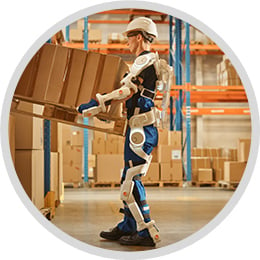Exoskeletons are devices that conform to the human body for rehabilitation or motion assistance purposes. Biomedical exoskeletons are designed to assist with constant, or temporary, partial immobility, whereas industrial exolskeletons are made to assist with physical activities of prolonged duration or redundancy. Motors, sensors, and servo drives in an exoskeleton act as components of the human body. Decrease your time-to-market with Celera Motion – the single supplier for all your precision motion component needs.
The Challenge
Exoskeletons are wearable robotic devices that work with a user to regain mobility or to assist/stabilize limbs, helping minimize fatigue and injury. This results in strengthening or replacing muscles for human motion. Exoskeletons can be driven in many ways, but most commonly they are electrically, mechanically, or hydraulically driven. The motors, sensors, and servo drives in the exoskeleton act as components of the human body. The nervous system, or in this case the servo drives, instruct the motors to move as the human brain does with muscles. The encoders monitor and respond to the motion.
Designing wearable machines that conform to the human body is challenging. Exoskeleton devices need to be small, light, compact, and reliable, delivering a trusted, comfortable, wearable solution.
Types of exoskeletons:
- Biomedical exoskeletons
- Industrial exoskeletons
Biomedical exoskeletons are designed for rehabilitation or motion assistance purposes. These help people who experience constant, or temporary, partial immobility. Industrial exoskeletons are made to assist workers that perform physical activities of prolonged duration or highly redundant tasks, such as working on a manufacturing assembly line. Some manufacturers are even making exoskeletons mandatory personal protective equipment (PPE) for specific tasks – transforming productivity and safety.
The Solution
The combination of ultra-small servo drives, high torque density motors, and precision encoders, make Celera Motion the right partner – supplying components and sub-system solutions that enable exoskeletons to be compact and flexible for increased wearability. The low profile Capitan Series servo drives can minimize the overall height of a joint, allowing the design to be flat, reducing overall weight, while maintaining excellent performance. Combined with the ultra-flat Omni+ Series motors, experience extremely high torque density, with large rotor ID to stator OD ratios, increasing design flexibility. Depending on the end application of the exoskeleton, two different encoder technologies can be considered: absolute optical or inductive. Aura Series absolute optical encoders provide the highest accuracy in a very small envelope, mostly used in clean environments for biomedical and industrial exoskeletons. The Mini Ultra IncOder Series inductive encoders are robust and reliable for the most challenging environments. These components enable very small, powerful, reliable, and precise motion control.
The Benefit
Exoskeletons are worn by human beings, therefore the overall temperature of the robot needs to remain stable and low. The very low heat generation of the Capitan servo drive allows the robot to remain wearable at all times. This tiny servo drive is 10.3 mm tall, and drives an RMS current of 10 A, with a PWM commutation frequency up to 200 kHz. The standby power consumption is only 1.2 W, making it a superior solution for battery powered devices. The Omni+ Series motors have thin cross-section form factors for tight integration.
The Aura Series absolute optical encoder is 9 x 7 mm in size – ultra-small with accuracy of ± 0.01°. Mini Ultra IncOder, available in 37 mm diameter, is designed with a through hole for convenient routing of cables or other system elements. This encoder is rugged, durable, and reliable, delivering resolution up to 20 bits. Decrease time-to-market with Celera Motion – the single supplier for all your precision motion needs.
Specifications
Capitan Series Servo Drives
| Capitan XCR | Capitan NET | Capitan CORE | |
| Continuous Current | 10 A | 10 A | 10 A |
| Standby Power Consumption | 1.5 to 2.1 W | 1.28 W | 1.12 W |
| Weight | 38 g | 18 g | 18 g |
| Dimensions | 42 x 29 x 9.4 mm | 34.5 x 26 x 10.3 mm | 34.5 x 26 x 10.3 mm |
| PWM Switching Frequency | 20, 50, 100, 200 kHz | 20, 50, 100, 200 kHz | 20, 50, 100, 200 kHz |
Omni+ Series Motors
| 60 mm | 70 mm | |
| KtTRAP* | Up to 0.353 Nm/ADC | Up to .507 Nm/ADC |
| KtSINE | Up to 0.306 Nm/Apeak | Up to 0.439 Nm/Apeak |
| Through Hole | 31 mm (Rotor ID) | 38 mm (Rotor ID) |
| Continuous Torque | 0.41 to 1.26 Nm | 0.51 to 1.56 Nm |
| Peak Torque | 1.2 to 4.94 Nm | 1.43 to 5.79 Nm |
| Rated Speed at 24V | Up to 7,000 rpm | Up to 7,000 rmp |
* Winding dependent
Aura Series Absolute Optical Encoders
| Accuracy | ± 0.01° |
| Repeatability | ± 1 LSB |
| Operating Temperature | -20 to 85° C |
| Weight | 1.5 g |
| Dimensions | 9.0 x 7.0 x 1.2 mm |
Mini Ultra IncOder Series Inductive Encoders
| Accuracy | ≤75 arc-seconds (depending on size) |
| Resolution Options | Up to 20 bits |
| Operating Temperature | -60 to 105° C |
| Dimensions | 37 and 58 mm (OD), 5 to 12.7 mm (ID) |
All specifications subject to change.





